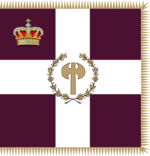National Youth Organization (Paretia)
This article is incomplete because it is pending further input from participants, or it is a work-in-progress by one author. Please comment on this article's talk page to share your input, comments and questions. Note: To contribute to this article, you may need to seek help from the author(s) of this page. |
| National Youth Organization Organização Nacional da Juventude | |
|---|---|
 Flag of the ONJ | |
| Chairperson | Queen Roberta II |
| Founded | 4 August 1926 |
| Dissolved | XX 1935 |
| Headquarters | Precea, Paretia |
| Membership | 2.5 million (1930) |
| Ideology | National Functionalism Palmeirism Paretian nationalism |
| Mother party | New Nation of Paretia Party |
The National Youth Organization (Luzelese: Organização Nacional da Juventude), abbreviated ONJ, was the youth wing of the New Nation of Paretia Party, the sole legal political party during the period of Functionalist Paretia. It was created for the framing and political indoctrination of the young Paretians according to the principles of National Functionalism and Novanism. It also was meant to train and help youth learn cooperation and national spirit in their free time.
It was created in 1926 as the successor to the Young PNNP Front, and was more an official part of the Paretian government than the PNNP party itself. It would be apart of the regime's national projects and national rallies. During the Great War it worked to train it's youth in combat and medicine.
It was lead by Ivan Montecalvo, a leader of the Visegan wing of the party who was originally a key member of the PNNP who eventually fell out of favor of the party leadership. He was ousted in 1933 and replaced by Cornélia Bastos and she lead the organization until her arrest in 1934.
Activities
The ONJ was a major part of the PNNP's control of the country. The organization participated in rallies, parades, athletic events, and worked on national projects. It also offered military training and environmental protection projects.
The organization has a list of goals for the Paretian youth called the Principals of Novanist National Functionalism:
- political education
- physical fitness
- military education
- political outreach
- charity
- education for running camps, shelters, and academies
- respect for the culture of Paretia and the church
- family education for female youth
- loyalty to party, nation, and state
The group also was tasked with creating propaganda for the regime, and ran a newspaper called The Youth (A Juventude).
Organization
The leader of the organization was approved by the National Chief of the New Nation of Paretia Party and the New State Movement Board, Carlito Palmeira. The board of members of the PNNPeMEN would appoint leaders of the organization for Palmeira to approve of.
The organization was divided into different levels and departments. The organization was given a physical education and religion advisor, them being General Inácio Torres e Rosário and Bishop Carlito Teixeira respectively.
There were many different units of the ONJ, such as the University Paretian Union (União Universitária Paretiana) which was located in university campuses and made of university students. There were sections related to teaching members different goals of the organization as according to the principals of the ONJ. Higher level members of the organization would then be given the ability to teach newer members the different parts of the organization and activities.
The organization also held vocational training competitions which could be between members and regional parts of the organziation, it eventually would compete internationally with other functionalist national youth groups such as in Gaullica, Ardesia, and Piraea.
The organization also had a Agricultural and Rural Section that focused on training for those who live in rural parts of Paretia. As well as sections specifically for youth women and men.
The organizationw as divided by age into different groups, Axes (from 10 to 13 years old), Cadets (from 14 to 16 years old) and Guides (from 17 to 20 years old). The basic unit was the squadron, and the commanders were called squad leader, bull, matador and legion.
Symbols
The symbol of the ONJ was the same as the symbol of the PNNP Regime and other functionalist regimes abroad, the labrys axe. The group had a flag that was a purple and white cross with the emblem in the middle.
The group also used youth bulls as the symbol for the younger members of the organization.

